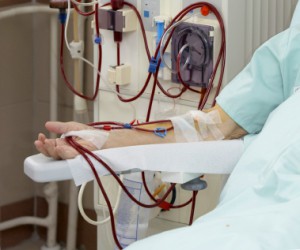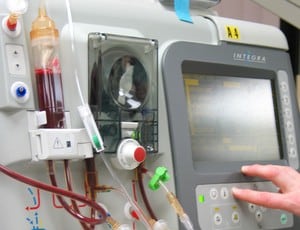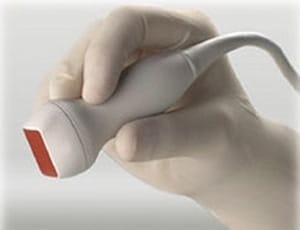The protective effect of central venous catheter locking solutions

The aim of this study was to analyze the impact of routine locking solutions on the incidence of CRBSI and ESI, in preserving catheter function, and on the rate of all-cause mortality in patients undergoing hemodialysis” Chen et al (2019). Abstract: Catheter-related bloodstream infections (CRBSIs) and exit-site infections (ESIs) are common complications associated with the […]
Reducing placement complications associated with tunneled catheters

Using modern-day techniques, the incidence of mechanical complications during placement of tunneled catheters can be diminished. Hence, routine use of ultrasound guidance for insertion of tunneled dialysis catheters should become the standard of care” Aurshina et al (2019). Abstract: OBJECTIVE: While placement of tunneled dialysis catheters for hemodialysis access is considered a routine procedure, it […]
Hospital epidemiologists’ and infection preventionists’ opinions regarding hospital-onset bacteremia and fungemia

To ascertain opinions regarding etiology and preventability of hospital-onset bacteremia and fungemia (HOB) and perspectives on HOB as a potential outcome measure reflecting quality of infection prevention and hospital care” Dantes et al (2019). Abstract: OBJECTIVE: To ascertain opinions regarding etiology and preventability of hospital-onset bacteremia and fungemia (HOB) and perspectives on HOB as a […]
Innovations in vascular access for hemodialysis

Worldwide, hemodialysis remains the prevalent dialysis modality for more than 2 million patients who require well-functioning vascular access for this procedure” Agarwal et al (2019). Abstract: Worldwide, hemodialysis remains the prevalent dialysis modality for more than 2 million patients who require well-functioning vascular access for this procedure. Creation of an arteriovenous fistula for long-term hemodialysis […]
Massive air embolism caused by a central venous catheter

We herein report a case of massive air entrainment from an inadvertently disconnected port of a central venous catheter (CVC) in the neck which culminated in an airlock of the ECMO circuit” Kumar et al (2019). Abstract: Extracorporeal membrane oxygenation (ECMO) has become an integral treatment option for patients as a bridge to transplant, management […]
Australian standard for the labelling of injectable medicines and administration lines

This National Standard for User-applied Labelling of Injectable Medicines, Fluids and Lines (the Labelling Standard) has been developed as a national solution to the risks posed by erroneous administration of injectable medicines” Australian Commission on Safety and Quality in Health Care (2015). Extract: “Incomplete or inaccurate labelling of injectable medicines and fluids (and the devices […]
Study of tunnelled haemodialysis central line-associated bloodstream infections

We aimed to describe the epidemiology of tunnelled haemodialysis central line-associated bloodstream infections (CLABSI) in an Australian centre” Krishnan et al (2019). Abstract: Infection is a serious complication of tunnelled haemodialysis catheters. We aimed to describe the epidemiology of tunnelled haemodialysis central line-associated bloodstream infections (CLABSI) in an Australian centre. We performed a retrospective audit […]
Unsuccessful removal of a totally implantable venous access port caused by thrombosis

Thrombosis is a common complication associated with implantable venous access ports (IVAPs) and often results in loss of catheter function but is rarely associated with difficulty in IVAP removal” Zhang and Geng (2019). Abstract: RATIONALE: Thrombosis is a common complication associated with implantable venous access ports (IVAPs) and often results in loss of catheter function […]
Implementation of a standard operating procedure for pediatric infliximab infusions

Feasibility was established for a standardized protocol to improve completion of a preinfusion safety checklist in children with IBD who receive infliximab” Kelly et al (2019). Abstract: BACKGROUND: The purpose of this quality improvement project was to decrease care variation regarding infliximab delivery at a pediatric inflammatory bowel disease (IBD) center. This variation was driven […]
PICC related complications literature review

We conducted a PubMed search to identify all relevant publications referring to infective complications after insertion and use of PICC lines in hospitalized adult patients” Velissaris et al (2019). Abstract: Peripherally inserted central catheter (PICC) lines are commonly used by clinicians in daily practice. This strategy has been established the latest years as a common […]
Arm placed implantable port insertion technique

c” Kehagias and Tsetis 92019). Abstract: PURPOSE: Central venous catheters or “venous access devices” include totally implantable venous access devices or “ports,” peripherally inserted central catheters, and tunneled lines. Venous access devices are now the standard of care in patients requiring long-term intravenous drug administration. Arm venous access device placement is a valuable option for […]
Care time and quality indicators in Intensive Care Units

This research may support methodological decisions for future investigations that seek the impact of human resources on the care quality and patient safety” Garcia et al (2019). Abstract: OBJECTIVE: To verify the correlation between nursing care time and care quality indicators. METHOD: Observational, correlational study, developed in 11 Intensive Care Units. The population comprised records […]
Assessment of device-associated infection rates in Tehran

Surveillance of health care-associated infections (HCAIs) is an integral part of infection control programmes, especially in intensive care units (ICUs). Device-associated infections (DAIs) are a major threat to patient safety” Afhami et al (2019). Abstract: BACKGROUND: Surveillance of health care-associated infections (HCAIs) is an integral part of infection control programmes, especially in intensive care units […]
Central venous guide wire retention literature review

Because of human nature, errors will always be possible when taking care of a patient. However, we propose good practice recommendations to avoid the repetition of a forgetting guide wire after central venous catheterization” Thonon et al (2019). Abstract: OBJECTIVES: Central venous catheter (CVC) implementation is now usual in emergency department. The most common complications […]
Ultrasonographic assessment of an induration caused by extravasation

Induration may occur after an anticancer drug extravasation in patients who recurrently receive chemotherapy because of reduced choice of an appropriate vein for inserting a peripheral intravenous catheter, resulting in catheter placement difficulty” Abe-Doi et al (2019). Abstract: RATIONALE: Induration may occur after an anticancer drug extravasation in patients who recurrently receive chemotherapy because of […]
Scalp intravenous catheter infiltration leading to subdural and intraparenchymal fluid collection

The scalp is a common site for obtaining IV access, and in children with hydrocephalus or wide fontanelles and sutures, there is a high probability of penetrating the meninges and brain matter with the scalp IV needle” Alexandru-Abrams et al (2019). Abstract: INTRODUCTION: Preterm infants require intravenous (IV) access for administration of medications, IV fluids, […]
Medication preparation and administration in pediatric and adult intensive care units

To determine the type, frequency, and factors associated with medication preparation and administration errors in adult intensive care units (ICUs) and neonatal ICUs (NICUs)/pediatric ICUs (PICUs)” Hermanspann et al (2019). Abstract: PURPOSE: To determine the type, frequency, and factors associated with medication preparation and administration errors in adult intensive care units (ICUs) and neonatal ICUs […]
Perioperative fluid management in children

Physiologically composed balanced isotonic electrolyte solutions are beneficial for maintaining homeostasis, shifting the status more towards the normal range in patients with preexisting imbalances and have a wide margin of safety in case of accidental hyperinfusion” Sümpelmann et al (2019). Abstract: PURPOSE OF REVIEW: The composition and type of intravenous fluids during paediatric anaesthesia have […]
The DermaPort percutaneous vascular access system

Although widely used, the polyester, cuffed, and hemodialysis catheter is far from ideal, and there is a need for an improved vascular access system to allow catheter adjustment and replacement, to reduce infections and to reduce medical costs. The DermaPort percutaneous vascular access system (PVAS) was developed to meet this need” Lobl et al (2019). […]
Vascular access catheters inserted with a vessel-sparing technique

This study was aimed at determining the flow pattern and constitution of the IJV after vessel-sparing implantation of an HC or Port and comparing the outcomes to those of implantation with the Seldinger technique” Ritz et al (2019). Abstract: Introduction: Both a Hickman catheter (HC) and port catheter (Port) can be inserted either percutaneously by […]
Current state of dialysis treatment and vascular access management in Japan

According to the data from the Japanese Society for Dialysis Therapy, the number of dialysis patients was about 330,000 at the end of 2016″ Sato et al (2019). Abstract: According to the data from the Japanese Society for Dialysis Therapy, the number of dialysis patients was about 330,000 at the end of 2016. The mean […]
Current concepts in hemodialysis vascular access infections

This review will provide an overview of hemodialysis catheter-, graft-, and fistula-related infections with emphasis on diagnosis and management in specific settings” Kumbar and Yee (2019). Abstract: Infection-related causes are second only to cardiovascular events for mortality among end-stage renal disease patients. This review will provide an overview of hemodialysis catheter-, graft-, and fistula-related infections […]
Prevalence of antiseptic tolerance genes among staphylococci and enterococci

Antiseptic tolerance is common among bloodstream staphylococci and E. faecalis isolates at TCH. Among CoNS, the presence of AT genes is strongly correlated with nosocomial acquisition of infection, consistent with previous studies in S. aureus” Sommer et al (2019). Abstract: OBJECTIVE: The smr and qacA/B genes in Staphylococcus aureus confer tolerance to antiseptics and are […]
Direct cost of peripheral IV catheterization by nurses

To measure the average direct cost of peripherally inserted central catheterization performed by nurses in a pediatric and neonatal intensive care unit” Pires and Lima (2019). Abstract: OBJECTIVE: To measure the average direct cost of peripherally inserted central catheterization performed by nurses in a pediatric and neonatal intensive care unit. METHOD: A quantitative, exploratory-descriptive, single-case […]
Bundled strategies for pediatric central venous catheter insertion

To investigate the factors that influence the knowledge and behavior of professionals of neonatal and pediatric units about bundled strategies of insertion of central venous catheter” Manzo et al (2019). Abstract: OBJECTIVE: To investigate the factors that influence the knowledge and behavior of professionals of neonatal and pediatric units about bundled strategies of insertion of […]
Management of obstruction caused by precipitated medication in central venous access devices

The target of this study was to analyze data regarding obstruction caused by precipitated medication or lipids in CVADs and to calculate the efficacy of different treatment methods” Zheng et al (2019). Abstract: At present, central venous access devices (CVADs) are widely used in clinical practice. The reasons for CVAD obstruction caused by precipitated medication […]
Comparison of performance among split-tip and symmetrical-tip hemodialysis catheters

Different tip designs (step, split, and symmetrical) have been developed to ameliorate the catheter-related problems. The aim of the study was to compare the efficacy and safety of split-tip, step-tip, and symmetrical-tip HD catheters” Ling metal (2019). Abstract: OBJECTIVE: Patients with end-stage renal disease need vascular access to ensure sufficient blood flow during hemodialysis (HD). […]
Modified approach for ultrasound-guided axillary venipuncture in the infraclavicular area

The ultrasound-guided oblique-axis/in-plane approach is a safe and reliable alternative to the routine ultrasound-guided approach for axillary venous catheterization” Yao et al (2019). Abstract: BACKGROUND: Catheterization of the axillary vein in the infraclavicular area has important advantages in patients with long-term, indwelling central venous catheters. The two most commonly used ultrasound-guided approaches for catheterization of […]
Survivorship rate of peripheral IV catheters placed in the emergency department

We compare the use and survivorship rate of peripheral intravenous catheters placed in the emergency department (ED) by insertion method” Shokoohi et al (2019). Abstract: STUDY OBJECTIVE: We compare the use and survivorship rate of peripheral intravenous catheters placed in the emergency department (ED) by insertion method. METHODS: We analyzed a prospective cohort of ED […]
Narrative review addresses vascular access device choice

This narrative review addresses vascular access device choice from peripheral intravenous catheters through central venous catheters, including the evolving use of midline catheters” Cawcutt et al (2019). Abstract: This narrative review addresses vascular access device choice from peripheral intravenous catheters through central venous catheters, including the evolving use of midline catheters. The review incorporates best […]

